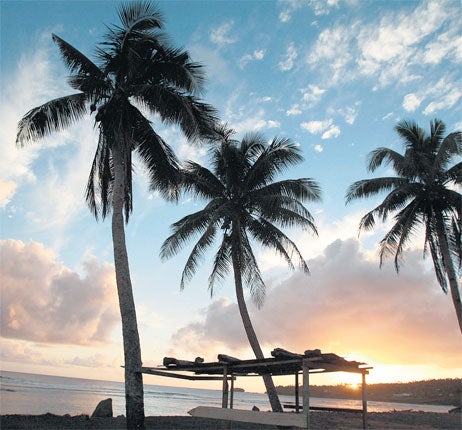Samoa skips from last to first country to see the sun

For visitors, the highlight of a trip to Samoa has always been the opportunity to stand on a rocky promontory at Cape Mulinu'u, the westernmost point of the planet, and – with the International Dateline only 20 miles away – to gaze into tomorrow.
Now the South Pacific nation, which has long marketed itself as the last place on Earth to see the sun set, plans to hop over the Dateline and become the first country to greet the new day.
The Samoan Prime Minister, Tuilaepa Lupesoliai Sailele Malielegaoi, said the change was necessary because the country – which used to trade mainly with the United States and Europe – was increasingly focused on commercial dealings with Australia and New Zealand.
Currently, Samoa is 23 hours behind New Zealand and 21 hours behind eastern Australia. That means it shares only four working days per week with its large western neighbours. The shift, to take place at midnight on 29 December, will make it "far, far easier and more convenient" to trade with those countries, Mr Tuilapea said.
Not everyone is happy. As well as introducing a large kink into the already jagged International Dateline, the move will separate Samoa from its nearest neighbour, American Samoa, a US territory. The two countries used to be united, until partitioned by Germany and the US in the late 19th century.
Tourism operators are concerned that Samoa is about to lose one of its main draws. A local tour guide, Andrew Titia, told The New Zealand Herald: "The fact that Samoa is the last place on Earth to see the sun every day is a great marketing point, and one in which I take great pride in telling our visitors. Once that's gone, we're just like the rest of the world."
The country last shifted time zone 119 years ago, when it vaulted from the western to the eastern side of the Dateline in order to be in step with traders in California. Now, with almost as many Samoans resident in Australia and New Zealand as the 180,000 who remain on the islands, Mr Tuilaepa has decided it is time to move back.
In 1892, Samoa made the switch on US Independence Day – celebrating 4 July twice. This time, Samoans will lose a day, gliding from 29 December straight to 31 December. From then on, the country will be one hour ahead of New Zealand and three hours ahead of eastern Australia. Meanwhile, American Samoa will become the last place on Earth to see the sun set.
Samoans are only just getting used to the last big change in their lives: switching from the right to the left-hand side of the road, bringing the country into line with Australia and New Zealand. But the change has been surprisingly smooth, with few accidents and motorists changing their habits with relative ease.
Explaining the latest move, Mr Tuilaepa said: "In doing business with New Zealand and Australia, we're losing out on two working days a week. While it's Friday here, it's Saturday in New Zealand, and when we're at church on Sunday, they're already conducting business in Sydney and Brisbane."
The Prime Minister has his own plans for boosting the tourism industry: once the changes take effect, visitors to the Samoan islands will be able to experience the same day twice, by flying between Samoa and American Samoa, just one hour apart.
"You can have two birthdays, two weddings and two wedding anniversaries on the same date – on separate days ... without leaving the Samoan chain," Mr Tuilaepa said.
Join our commenting forum
Join thought-provoking conversations, follow other Independent readers and see their replies
Comments